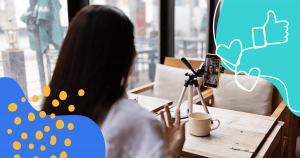If you’ve made the decision to outsource a web designer to redesign your website, or create a new one, you have a long process ahead of you. Website design affects your relationships with your customers and your company’s financial well-being, so ensuring good web design is key.
The principles of effective web design are complicated enough, but they don’t have to cause you difficulty. These principles follow a logical progression and are based on fundamental concepts related to human behavior, aesthetics, and testing.
Below you will find 10 web design tips backed by research. Use them and you will see that your income from your website can be bigger than now.
What’s the value of web design for business?
Web design works to promote products online and popularize the brand. With great web design, businesses can get more targeted website actions, brand awareness, secure online transaction and therefore sales. The smaller the team web designers work for, the more skills they need to possess. Lastly, a better website looks good not only for your customer but your supplier as well – supplier perception is a very real element of a quality website.
Good web design is emotional and evocative: on phones, tablets, widescreen monitors. Good web design evokes positive emotions in visitors. It evokes pleasure, joy, surprise, anticipation combined with a bright personality. And it is also commercially effective, useful, and easy to work with.
There is still a lot of work for web designers. Everywhere exist typical and monotonous online stores, information portals, services, etc. Monotony – not the best tool for attracting customers. An alternative to it is expressiveness, but web designers` attempts to stand out lead to frankly failed results and cause only irritation to users. So, let’s consider 10 web design tips backed by research.
10 web design tips backed by research
1. Make site speed an absolute priority
We’ve all experienced the frustration of trying to navigate a site with long load times, but many people don’t know that the downside of slow loading goes beyond being a nuisance to users. Research has found that a delay of as little as half a second in page loading resulted in a 20% reduction in traffic and ad revenue. So it’s important to remember that well-designed websites not only look good, they also function well. Moreover, a few years ago, Google decided to factor page load speed into its ranking algorithm, and while it’s not as important as search relevance, that metric can still affect performance.
2. Direct attention with visual cues
A space on a webpage creates a powerful psychological effect because it automatically draws the reader to identifiable design elements elsewhere on the webpage. You can also use instinctive visual cues, such as faces, to direct your audience in the right direction to pay attention to a particular spot on the screen. By the way, it was proved by research.
Have you ever wondered why so many companies so often use images of babies on their website pages? The effectiveness of this technique is explained in research, which says that our natural parental instinct causes us to focus on unfamiliar infant faces for much longer than adult faces. Additionally, having high converting web copy is a great way to drive actions on your website, you can use proven copywriting strategeis to improve your click-through-rate (CTR) conversions.
Finally, to create a website that is both appealing and useful, consider using minimalist principles to avoid unnecessary stimuli that overwhelm the audience.
3. Avoid carousels, sliders, tabs, and accordions
Most companies want elements on their website that are completely unique because they believe it fits with brand attributes such as innovation and creativity. This is an understandable goal, but they are mistaken if they believe that uniqueness in features is a necessary component of effective web design. Much better to have a familiar and logical design than a design that is unique and breaks all patterns as well as confuses the audience. Most such companies are trying to use carousels, sliders, tabs, and accordions in their web design.
Scott Chow from The Blog Starter cites Notre Dame University research that shows that the first slide on a carousel gets almost 90% of the clicks while the rest slides are ignored. At the same time, another research says tabs and accordions are ignored as well as sliders and carousels. So, if you want your web design to be more effective, avoid carousels, sliders, tabs, and accordions.
4. Keep it simple
If you’re frantically checking every element of your web design and yet you find that all of your changes are barely working, it’s time to look around. Think maybe the problem isn’t the aesthetic elements. A huge study by Google has shown that visitors don’t like visual complexity. If your content isn’t satisfying 79% of your audience, you should make it easier.
Plan your web design with users’ interests and goals in mind. While users may appreciate evocative images and intricate layouts, the reality is that their goals for visiting a website are usually based on something else. They came to your website with a specific purpose because they want something, whether it’s to find the information they need, to subscribe or sign up for an account, to make a purchase, etc.
Almost any element of a web page that is part of user interaction can be tested in several ways. This includes details such as font color and style, the size of the call to action button. This testing can have serious implications for the performance of your website, as even a small increase in clicks or conversions can result in something significant once each element is properly the best database for web apps.
Gmelius, a web design business, can help you with website design. Gmelius offers great pricing plans for people who need to make websites. The company has some great tips on how to design a website the best way possible. Some of the tips are about choosing a niche, focusing on your target audience, and using more images to give your site more appeal.
5. Remember Hick’s Law
Behavioral psychology, especially as it relates to consumers, is really the concept behind effective web design. People have specific and detailed responses to colors, shapes, fonts, images, and every visual element on the page. For example, Hick’s Law states that the more choices person has, the longer he or she will decide. This means the more options are in your web design, the longer visitors will choose one among them.
There is also one more excellent piece of research. This study was in a supermarket with different varieties of jam. People with more jam choices were much less likely to end up buying some jam. People that had less variety to choose from were much more likely to end up buying some jam.
The best web designs evoke different emotions from users and guide them through a series of emotional states. When creating a web design, you should always clearly understand and realize that the ultimate goal is not aesthetic beauty for its own sake, but the ability to influence user actions and reactions.
6. Remember the “F” pattern
People are habits, and the way they consume content is no exception. A Nielsen Norman Group eye-tracking study found that when a person scans information on a website, he or she does so in the shape of an “F”. This means that a person first reads important headlines along the top of the webpage, then scans the left side of the webpage for any numbers, markers, or sidebars, and then goes back across the webpage for any bold text or subheadings. In web design, using the “F” pattern involves mimicking the natural path of the eye so as not to disrupt the visual flow.
7. Remember the “Z” pattern
Although the “F” pattern is a common eye scanning pattern, it is not the only one. The “Z” pattern is another important design principle. It is when the eye scans from left to right, forming an imaginary horizontal line. It then descends to the left side of the webpage, forming an imaginary diagonal line. Finally, it goes back to the right again, forming a second horizontal line.
So, when would you use layout “Z” over “F”? While the “F” pattern tends to work best for landing pages, the Z pattern tends to work best for web pages with very minimal information, where the main requirement is a call to action.
Moreover, you’ve already seen the “Z” pattern in action because it’s used on a Facebook login page! Naturally, the look is directed at the logo, but the “Z” pattern directs users through two calls to action – log in or join.
8. Remember 8-second rule
Microsoft study shows that you only have 8 seconds to grab a user’s attention. That’s how long a person can concentrate on one thing. You have a very small window of opportunity to interact with the user when they get to the website. Here are some tips for grabbing attention in the first 8 seconds and increasing conversions:
- Use a great prominent headline that speaks briefly and essentially about the benefits of your product.
- Use standout images that convey the main purpose of your page and draw attention to the main call to action.
- Make the call-to-action button big, simple, and easy to understand.
- Use special words to make your offer more appealing.
- Use a hover effect on your buttons (such as changing the color or cursor when hovering) to increase the desire to click them.
So, you need to catch visitors’ attention as quickly as possible. Sellfy to efficiently sell merchandise use a great prominent headline, standout image, and easy-to-understand instruction on the main webpage. All this helps Sellfy to interest the target audience in less than 8 seconds.
9. Remember Fitt’s Law
Fitt’s Law, created by psychologist Paul Fitts in 1954, states that the time it takes to move to a target is directly related not only to its distance but also to the size of the target. Although this theory originally referred to the human motor system, it is now a central tenet of UX (user experience) design. The idea is that the elements should be large and close to users if you want your visitors to click them. This idea is most often used in relation to buttons.
10. Use social proof
What started as a web content innovation has now become an industry standard. To differentiate yourself from the competition and prove that your website is trustworthy, it needs to have worthy testimonials.
The best way to brag about your reviews from valued customers is navigation. in an engaging and easy way to navigate. It’s a great way to establish trust and assure your visitors of the authenticity and quality of your website and services. After all, even before you buy a new phone case, you’re likely to take a quick look at reviews first.
Conclusion
According to a Stanford University study, 46.1% of people say that website design is one of the three most important criteria for deciding whether a company is trustworthy. That’s why it’s important that your website looks professional. Quality, well-designed website design increases conversions.

![[ROCK NA] [EBOOK SEO] Complete Guide](https://rockcontent.com/wp-content/uploads/2024/06/banner_Search-Engine-Optimization.png)






